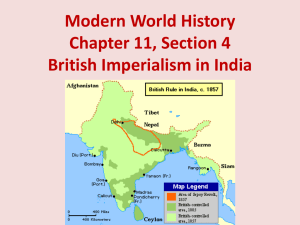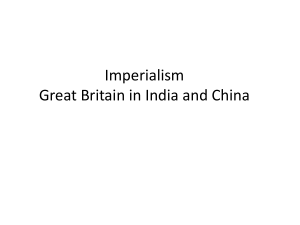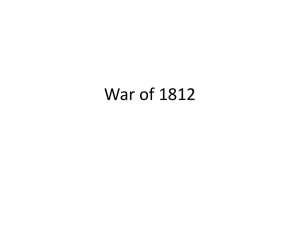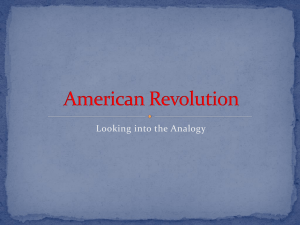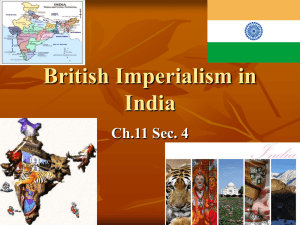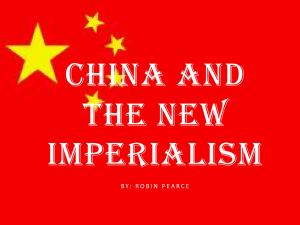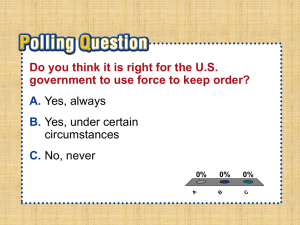Unit 10 part 3
advertisement
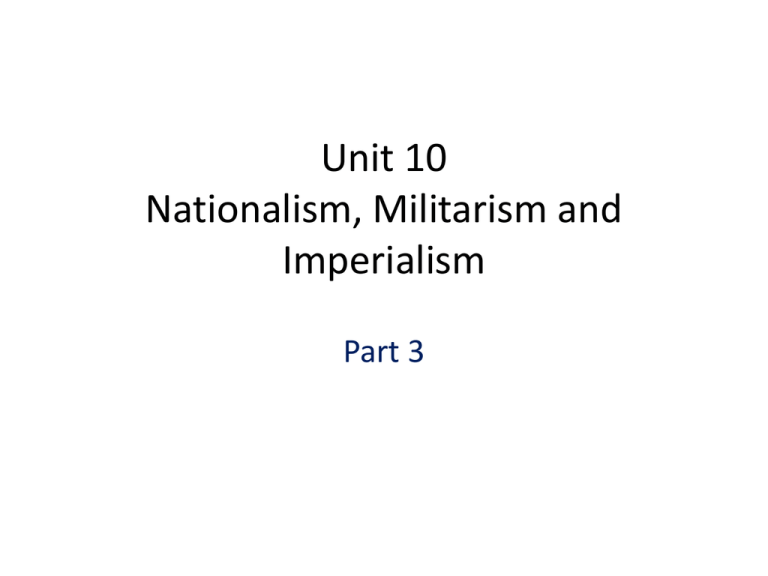
Unit 10 Nationalism, Militarism and Imperialism Part 3 24-4 The British Take Over India In the 1600s the British East India Company gained trading rights on the fringe of the Mughal empire. As the Mughal empire declined, the British gained control. By the mid-1800s the company controlled three-fifths of India. The Mughal Empire India was a land of great diversity. Britain exploited that diversity to gain control. India was home to many cultures and peoples. When the Mughal empire began to crumble, these groups could not unite to expel outsiders. Britain took advantage by encouraging competition between rival princes. The East India Company’s goal was to make money, which it did, but British policies aimed to improve India as well. • Roads were improved and banditry was reduced. • They pushed for social changes such as the ending slavery and the caste system. • Sati, the practice of a wife’s killing herself on her husband’s funeral fire, was banned. British insensitivity to local customs led to the bloody Sepoy Rebellion in 1857. • The sepoys were Indian soldiers hired to fight for the British. • The British issued a number of rules that angered the sepoys and finally provoked them to rebel. Sepoys were ordered to serve overseas. For high-caste Hindus, such travel was forbidden. Company rules allowed Hindu widows to remarry. The sepoys saw this violation of Hindu practice as an attempt to Christianize them. New rifles were issued in 1857. To load the rifle one had to bite off the end of a bullet cartridge. The cartridges were greased with cow or pig fat. Cows were sacred animals to Hindus, and pigs were forbidden to Muslims. When sepoys were ordered to load their rifles they refused. These resisters were arrested for failing to follow orders. The sepoys rose in rebellion against the British. Some massacred British civilians. British troops retaliated, killing thousands of unarmed Indians. After the Sepoy Rebellion, Britain took control of India from the East India Company. • British troops were sent to India, and Indians were taxed to pay for them. • Indians were angered at how Britain extracted great wealth from India. Parliament set up a system of colonial rule called the British Raj. • A British viceroy ruled in the queen’s name. • High officials were British, but Indians held lower posts. • With some local cooperation, India became the crown jewel of the British empire. British rule brought some benefits to India. Britain revised the legal system. Britain built rail and telegraph lines. Upper class Indians benefited the most. They promoted equality and justice regardless of caste. • There was more peace and order. • Indians were able to travel and communicate more easily. • Indians began to unite. • The upper classes benefited from a British education. • Indian princes and landowners grew wealthy from trade. • However, changes favored the British. Britain felt they were helping India to modernize, but policies favored the British. When Britain flooded India with machine made textiles, it ruined India’s prosperous handweaving industry. The British encouraged farmers to grow cash crops. This led to deforestation, shortages of food, and terrible famine. Indians were divided in their attitudes toward modernization and Britain. The upper class and educated Indians adopted more modern ways. Hindu and Muslim religious leaders opposed British-style modernization. Ram Mohun Roy tried to combine the old and the new in the early 1800s. He founded Hindu College, which provided an Englishstyle education. He saw the need to reform practices such as sati, castes, and child marriages. Roy saw the value of European ideas and reform, but he wanted to preserve Indian culture as well. The British were also divided in their attitudes toward Indian culture. As Indian classics were translated, many Englishmen gained respect for Indian literature and religious ideas. Paternalistic English leaders such as historian Thomas Macaulay had little respect for other cultural traditions. British leaders assumed that providing Indians with a British education would lead them to accept British culture and rule. The opposite took place; educated Indians returned home and began nationalistic movements. • In 1855 the Indian National Congress met to propose self-rule and democracy. • Fearful that Hindus might dominate any government, Muslims began talking about a separate state. How did Britain gradually extend its control over most of India, despite opposition? 24-5 China and the New Imperialism Prior to the 1800s China’s relationship with the West was different. • China had long enjoyed a favorable balance of trade with Europeans. • The Chinese limited where, how much, and when European merchants could trade. • China exchanged porcelain, tea, and silk for gold and silver and enjoyed a trade surplus. By the late 1700s, two developments changed this relationship. • China entered a period of decline. • Europe gained power due to its Industrial Revolution. British merchants also began selling opium to the Chinese, causing gold to flow out of China and disrupting the economy. To stop the use of drugs, China outlawed opium and executed the drug dealers. Britain would not stop the sales, saying they had a right to free trade. The result was the Opium War in 1839. The Chinese were no match for British gunboats and were easily defeated. The Chinese were forced to sign the Treaty of Nanjing. The treaty included payment of a huge indemnity to Britain (Britain also gained Hong Kong)and granted British subjects in China extraterritoriality. The treaty was the first of several forcing China to make concessions. A second war forced China to open her ports and to allow in Christian missionaries. Massive floods in the Huang Valley resulted from failure to maintain dams and dikes. While peasants suffered with high taxes, the imperial court lived lavishly. Suffering peasants rebelled between 1850 and 1864. Imperial forces eventually put down this Taiping Rebellion. Between 20 and 30 million people died. The death and destruction of the Taiping Rebellion led to debate about the need for reform. • Most saw no need to adopt Western industry. • Western technology was feared as disruptive. • Scholar-officials opposed Western ideas of individual thought. The Confucian way had served China well for centuries, and most feared changing what worked. Reformers in the 1860s began the “self-strengthening movement,” translating Western works and developing Western-style industries. In the late 1800s Empress Ci Xi gained power. She opposed change and was committed to Confucian tradition. While China debated, Japan embraced Western technology. • In 1868 Japan began to modernize. • In 1898 Japan joined the Western imperialists in competition to develop an empire in China. In the Sino-Japanese War that followed, China lost the island of Taiwan to the Japanese. China’s loss revealed its weaknesses. European powers moved in to demand concessions and to carve up spheres of influence. Imperialism in China The United States, a long-time trading partner, opposed these spheres of influence and demanded an “open door” to trade. The Europeans accepted this Open Door Policy. No one asked the Chinese, who had to accept it. Reformers blamed the conservatives for China’s failure to look ahead. • Young emperor Guang Xu launched the “Hundred Days of Reform” in 1898. • He sought to modernize the bureaucracy, schools, the military, and industry. But Empress Ci Xi and the conservatives retook control, executed Guang Xu, and halted reform. In 1900 a secret society, “The Righteous Harmonious Fists,” launched an attempt to drive the “foreign devils” out of China. The Boxer Rebellion attacked foreigners all across China. But the Western powers defeated the Boxers. As a result of the Boxer Rebellion, even conservatives had to admit that China needed to modernize. • China had been forced to grant concessions to foreigners again. • Schools were changed, and women were now allowed to attend. • China began to expand economically; a business class emerged. Though the Boxer Rebellion failed, the flames of Chinese nationalism had been fanned. By the early 1900s, reformers created a constitutional monarchy, and some even called for a republic. In 1911 a rebellion overthrew the Qing dynasty. A republic was set up under Sun Yixian, who advocated the “Three Principles of the People.” • Nationalism—removal of foreigners • Democracy—representative government • Livelihood —economic security for Chinese people How did Western powers use war and diplomacy to gain power in Qing China?




